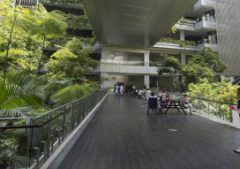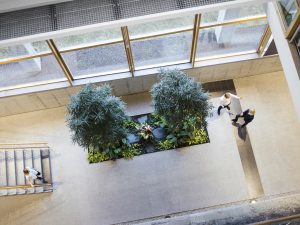Increasingly, green building project teams have attempted to incorporate biophilic design into their projects, but often their efforts amount to adding trees and plants or water features to their buildings.
I believe this is because nothing in their training or backgrounds has prepared them for this exercise, and their experience with green building rating systems has trained them to fulfill the minimum requirements of a checklist without thinking past that step. True biophilic design goes much further and deeper, drawing on the intrinsic psychology that is mapped in our brains calling for us to be connected deeply to the natural world. Embedded within the Living Building Challenge program since the beginning, we are starting to see biophilic design explorations of a new rigor.
 Amanda Sturgeon. Courtesy ILFI
Amanda Sturgeon. Courtesy ILFI
Although the frameworks developed by [Stephen] Kellert and others are helpful, there is no easy checklist to bring biophilic design into mainstream design practice; the principles do not translate easily into code language. This is because biophilic design is a philosophy that requires a shift in thinking. Though its benefits can be quantified, biophilic design draws as much from intuition and emotion as it does knowledge and formal training. It requires each individual to tap into the instinct that guides them to pay more for a home with a view of a park, the mountains or a lake, or to live on a street lined with trees.
How can we encourage this shift in thinking, one that inspires and instructs creators of buildings to think systematically, and to use biophilic design as the design driver instead of applying it as an afterthought?
The long-view answer is that such a shift starts early, with children, at home and in schools, with parents and teachers who help foster the bonds between children and the natural world by encouraging exploration, play, and wonder. Simply spending time in natural landscapes and with plants and animals nurtures the relationship. And the good news is that, in some places, efforts to increase ecological literacy among the younger generation is rising. But what about aspiring architects and designers, and those who are already practicing?
First, those of us in the position to mentor young design professionals must change our approach. We must train architects and designers to think and act systematically and design holistically, and we must help them develop inspirational tools to communicate to building owners and developers the profound and positive impacts of biophilic design on building occupants. Some models and resources already exist. Organizations such as Terrapin Bright Green provide services intended to help restore the connections between people and the environment; for example, biophilic design workshops and charrettes lead design teams through creative thinking sessions, during which participants explore specific biophilic design strategies for improving health and wellness.
 READ: Singapore’s Khoo Teck Paut Hospital wins first Stephen S. Kellert Award for Biophilic Design
READ: Singapore’s Khoo Teck Paut Hospital wins first Stephen S. Kellert Award for Biophilic Design
We at the International Living Future Institute believe that such a collaborative approach is key to propelling these ideas forward; consequently, we have invited leading experts in biophilic design to help launch the Biophilic Design Initiative, which aims to achieve broad adoption of Biophilic Design among the design community, building owners, and cities. Through this initiative, we are creating a repository for ideas, research, and collaborative opportunities. We will connect project teams with biophilic design practitioners and resources, and we will connect design practitioners with research scientists, all while compiling a research databank.
Equally important for accelerating this shift, we need built examples— projects that demonstrate how biophilic design, when used as the design driver, can positively transform both the design process and the resulting building environment for occupants. We need built examples that intentionally draw from our instinctual connection to nature. We need built examples that demonstrate the positive impacts of biophilic design on energy performance, comfort, health, and productivity.
Fortunately, with each passing year, we have more such projects. I was motivated to write this book to disseminate these examples to as many practitioners as possible, not only to showcase the results but to illuminate the process. The [14 case studies in the book] vary in scope, climate zone, setting, and other particularities. Each draws on the specific city of place—its climate, ecology, culture, and landscape—to create rich, nurturing built environments that support occupants’ health and feed their yearning for connection. These buildings are a starting
point on the pathway to creating truly biophilic buildings, and they provide us with clear examples, methodologies, and lessons learned.
For each case study, I use Stephen Kellert’s framework of Biophilic Design Elements and Attributes to elucidate the project‘s biophilic design achievements. I believe that Kellert’s list, created in collaboration with Judith Heerwagen and others, is the most thorough framework we have, and working with it can help building professionals embrace a new design philosophy. As we approach our drawing boards, this framework provides a place to start thinking about how to create places where people and nature can thrive together. This is a new way of thinking for most architects, designers and owners and developers of buildings, but embracing this approach is completely mandatory if the human species is to survive, and what is more thrive, on this planet.
This column was excerpted from the new book, Creating Biophilic Buildings, by Amanda Sturgeon as another in our Building Thought Leader series. Sturgeon, an American Institute of Architects fellow with roots in Great Britain and Australia, has served as CEO of the International Living Future Institute since 2015. The photo at the top of the page Te Kura Whare was provided with permission from Ecotone Published.






